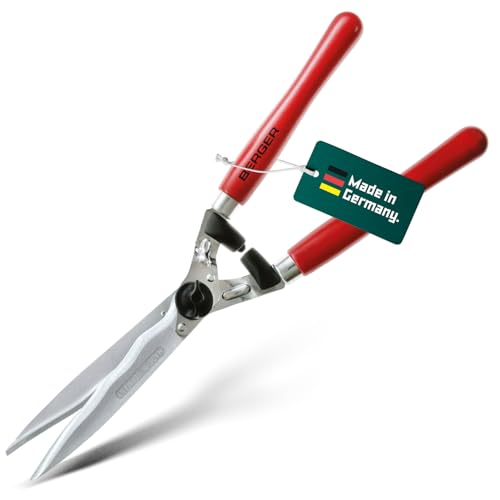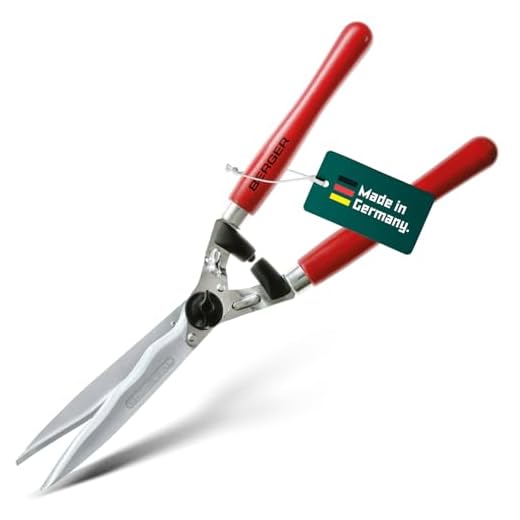




Hedges are a beautiful addition to any garden, but they can quickly become overgrown if not properly maintained. Hand hedge shears are an essential tool for keeping your hedges neat and tidy. However, over time, the blades of your shears can become dull and less effective. To ensure that your shears are performing at their best, it’s important to sharpen them regularly.
Sharpening hand hedge shears may seem like a daunting task, but with a little know-how, it can be easily done at home. There are a few different techniques you can use to sharpen your shears, depending on your preferences and the tools you have available. In this article, we will guide you through the process of sharpening your hand hedge shears step by step.
Step 1: Clean the blades
Before you start sharpening your hand hedge shears, it’s important to clean the blades to remove any dirt or debris. Use a soft brush or cloth to wipe away any loose particles, and then wipe the blades with a damp cloth. This will ensure that you have a clean surface to work with and will prevent any contamination of the sharpening tools.
Continue reading the article to learn more about the next steps in sharpening your hand hedge shears!
Importance of Sharp Hand Hedge Shears
Having sharp hand hedge shears is essential for maintaining healthy and aesthetically pleasing hedges and shrubs. Blunt or dull shears can cause damage to the plants, resulting in uneven cuts, torn stems, and increased vulnerability to diseases and pests. Sharpening the blades of your hedge shears regularly ensures that your gardening tool performs optimally, providing clean and precise cuts for a neat appearance.
Benefits of Sharpening Hand Hedge Shears
1. Improved Cutting Efficiency: A sharp blade requires less effort to make clean cuts, reducing strain on your hands and arms during trimming tasks.
2. Neat and Healthy Hedges: Sharp shears create smooth cuts that promote healthy growth, as plants heal faster and are less susceptible to infections and pest infestations.
3. Time-Saving: With sharp hand hedge shears, you can complete your hedge trimming tasks efficiently, saving time and allowing you to focus on other aspects of your garden.
4. Precision and Control: Sharp blades allow for more precise cuts, enabling you to shape your hedges and shrubs with greater accuracy and control over the final result.
5. Durability: Regularly sharpening your shears extends their lifespan, ensuring they remain effective and reliable for years to come.
How to Maintain Sharp Hand Hedge Shears
1. Clean the Blades: Remove any dirt, sap, or debris from the blades before sharpening to prevent contamination during the sharpening process.
2. Lubricate the Pivot Point: Apply a small amount of oil or lubricant to the pivot point of the shears to ensure smooth and easy operation.
3. Use Proper Sharpening Techniques: Follow the manufacturer’s instructions or seek guidance from a professional to sharpen your hedge shear blades correctly. Different types of shears may require different sharpening techniques.
4. Test the Sharpness: After sharpening, test the blades by making a few cuts on a small branch to ensure they are sharp enough to produce clean cuts.
5. Regular Maintenance: Incorporate regular maintenance and sharpening into your gardening routine, aiming to sharpen your hand hedge shears at least once or twice a year, depending on your usage and the condition of the blades.
| Summary |
|---|
| Having sharp hand hedge shears is crucial for maintaining healthy and attractive hedges and shrubs. Regularly sharpening your shears not only improves cutting efficiency but also promotes neatness, precision, and durability. By following proper sharpening techniques and incorporating regular maintenance, you can ensure that your hand hedge shears remain sharp and effective for years to come. |
Tools required for sharpening hand hedge shears
Sharpening your hand hedge shears is essential for maintaining their cutting efficiency and prolonging their lifespan. To successfully sharpen your shears, you will need the following tools:
- Sharpening stone or file: A sharpening stone or file will be used to remove any nicks or burrs on the cutting edges of the shears. Choose a stone or file with the appropriate grit for your shears’ blade material.
- Lubricating oil: Lubricating oil is necessary for keeping the shears’ moving parts smooth and reducing friction during the sharpening process. Use a high-quality lubricating oil suitable for metal tools.
- Safety gloves: Wearing safety gloves will protect your hands from potential injuries while handling the shears and the sharpening tools.
- Eye protection: Eye protection, such as safety goggles, should be worn to shield your eyes from flying metal shavings or debris during the sharpening process.
- Cleaning brush: A cleaning brush will be handy for removing any dirt, grime, or sap buildup on the shears before sharpening them.
- Rag or cloth: Have a rag or a cloth nearby to wipe off excess oil or clean the blades after sharpening.
- Flat file: A flat file can be useful for reshaping or leveling the cutting edge if it is severely damaged or misaligned.
Steps to sharpen hand hedge shears
Keeping your hand hedge shears sharp is important for maintaining their effectiveness and preventing damage to your plants. Follow these steps to sharpen your hand hedge shears:
- Clean the shears: Before sharpening the blades, make sure to clean off any dirt or debris that may be present. Wipe down the blades with a cloth or brush to remove any buildup.
- Inspect the blades: Check for any signs of damage, such as nicks or chips. If you notice any serious damage, consider replacing the blades instead of sharpening them.
- Select the right sharpening tool: There are several options for sharpening hedge shears, including whetstones, sharpening files, and sharpening stones. Choose the tool that best suits your needs and preferences.
- Secure the shears: Use a vice or clamp to secure the shears in place while you sharpen the blades. This will help ensure your safety and allow for better control during the sharpening process.
- Sharpen the blades: Start by positioning the sharpening tool at the base of the blade and moving it along the cutting edge towards the tip. Repeat this motion several times, applying light pressure and maintaining a consistent angle.
- Test the sharpness: After sharpening, carefully run your thumb along the cutting edge to check for sharpness. Be cautious to avoid injury, as sharpened blades can be very sharp. If needed, continue sharpening until the desired sharpness is achieved.
- Oil the shears: Once the blades are sharpened, apply a thin layer of lubricating oil to help prevent rust and keep the shears in good condition. Wipe off any excess oil with a clean cloth.
- Store properly: After sharpening and oiling, store your hand hedge shears in a dry place to prevent moisture buildup and further rusting. Keeping them in a protective case or hanging them on a pegboard can help maintain their sharpness.
By following these steps and regularly sharpening your hand hedge shears, you can ensure that they remain in excellent working condition and provide clean, precise cuts for your hedges and shrubs.
Common mistakes to avoid while sharpening hand hedge shears
Sharpening hand hedge shears is an important task that helps maintain their cutting performance and extend their lifespan. However, there are common mistakes that people often make while sharpening their shears. To ensure you get the best results and avoid any damage to your shears, keep these common mistakes in mind:
-
Using the wrong tools
Using improper tools can cause more harm than good to your shears. Avoid using a grinding wheel or a power grinder as they can generate excessive heat and damage the temper of the blades. Instead, use a specially designed sharpening stone or a honing guide to achieve the desired sharpness.
-
Not cleaning the shears before sharpening
Before sharpening your shears, it is important to clean them properly. Remove any dirt, sap or debris that may have accumulated on the blades. This will ensure a smooth sharpening process and prevent any clogging of the sharpening tools.
-
Over-sharpening the blades
While it is important to sharpen the blades adequately, over-sharpening can lead to a loss of blade integrity. Excessive sharpening can weaken the blades and make them more prone to bending or breaking. Follow the manufacturer’s guidelines or seek professional advice to determine the optimal level of sharpness.
Custom ToolTecomec Hedge Trimmer Sharpening ToolEssential for maintaining trimmersThis attachment is designed to sharpen your hedge trimmers effectively, ensuring they perform at their best for every job. -
Not maintaining the correct angle
Maintaining the correct angle during sharpening is crucial for achieving a durable and sharp edge. Avoid changing the original angle of the blades, as it can affect their cutting performance. Use a sharpening guide or carefully match the existing angle while sharpening.
-
Skipping the finishing step
After sharpening the blades, it is important to finish the process properly. Use a leather strop or a fine grit sandpaper to remove any burrs or inconsistencies left during sharpening. This will result in smoother cutting action and cleaner cuts.
By avoiding these common mistakes, you can ensure that your hand hedge shears remain sharp and effective for a long time. Regular maintenance and proper sharpening will not only save you time and effort but also provide you with clean and precise cuts while trimming your hedges.
Additional tips for maintaining sharp hand hedge shears
Keeping your hand hedge shears sharp is essential for achieving clean and precise cuts. Here are some additional tips for maintaining the sharpness of your shears:
1. Clean your shears after each use
After using your hand hedge shears, make sure to remove any debris, such as twigs or sap, that may have accumulated on the blades. Use a clean cloth or a brush to wipe down the shears and remove any dirt or grime. Dirt and sap can build up on the blades and hinder their cutting ability.
2. Avoid cutting branches that are too thick
Hand hedge shears are designed for trimming and shaping hedges with thin branches. Avoid cutting branches that are too thick for your shears, as this can cause the blades to become dull or even damage them. If you encounter thicker branches, use a different tool, such as loppers or a pruning saw.
3. Store your shears properly
Proper storage is important for maintaining the sharpness of your hedge shears. After cleaning them, make sure to dry the blades thoroughly to prevent rust. Store your shears in a dry place, preferably in a sheath or a case to protect the blades and prevent accidental damage.
4. Regularly oil the pivot
The pivot is the joint where the two blades of the shears connect. Regularly lubricating the pivot with a few drops of oil can help keep your shears operating smoothly and prevent them from getting stuck or becoming stiff. Use a lightweight machine oil or a specific lubricant designed for hedge shears.
By following these additional tips, you can keep your hand hedge shears sharp and in optimal condition for effortless trimming and shaping of your hedges.








